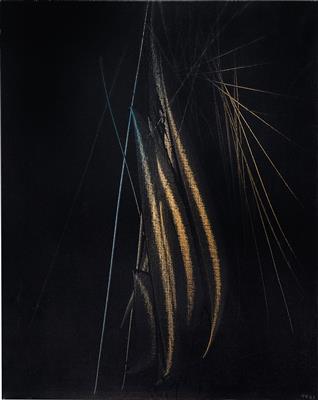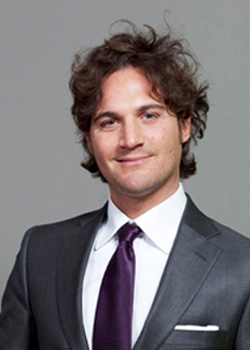Hans Hartung *

(Leipzig 1904–1989 Antibes)
T1963-R49, 1963, signed and dated 63, titled on the reverse, acrylic on canvas, 92 x 73 cm, framed
This work is registered in the Fondation Hans Hartung et Anna-Eva Bergman, Antibes and is accompanied by a photo certificate of authenticity
It will be included in the Catalogue raisonné de l’oeuvre de Hans Hartung currently being prepared
Provenance:
Gio Arte, Mestre (stamp on the reverse)
European Private Collection
A prominent exponent of Art Informel, an artistic movement born in the aftermath of World War II from the need to bring forth a new language through which to process its trauma, Hartung no longer believed in figurative representation or rigid geometric abstraction, maintaining the need to experiment with a type of painting which recognises the gesture and the sign.
The rejection of form was already characteristic of other artistic movements, but Art Informel distinguishes itself in the specific attention conferred on the creative gesture: the artistic event, which is exhausted in the very act of its creation.The work becomes witness to an experience and to a continual process of becoming.
Hartung knew the works of Franz Marc and Kandinsky and he certainly recognised the validity of their first intuitions, the reliable premises of their work. But he also knew to locate these works in their own time, recognising in his own coloured marks and signs a different conception of art, adopted via an impassioned and, very often, dramatic experience.
Before the war, my marks had begun to be accompanied by wide and dark strokes that prefigured those “beams” which, for many painters, would come to play a very important role after the war. At the same time, I rapidly rediscovered the “expressionist” style – my beams extended aggressively across the canvas like prison bars. My drawings were crossed by strange, contorted strokes, tangled and frantic like scratches. I made some of them on those school blackboards, made out of cardboard with red squares, which at least had the benefit of being cheap. It was vehement, rebellious painting. (Hans Hartung, Autoritratto, Fondazione Torino Musei, Turin 2000, p. 144)
Hartung’s mark derives from apparently rapid and decisive, yet studied, gestures; it is a confident, clear gesture than scratches the canvas or metal plate creating tension between the background and surface. The sign aggressively occupies space.
However, it is worth underlining that Hartung spoke “of improvisation but not of automatism, thus denying that the rapidity of the gesture could give birth to a solely automatic writing. The variety of lines and strokes that result from the painter’s action on the canvas demonstrate, in a type of ideal diagram, how different emotional moments manifest themselves – in the wide furrows, in the threadlike spirals, in the nervous scratches, in the vertical graphic combinations, in the fantastic arabesques, in the detailed interweavings.
A mysterious world composes and decomposes itself along the thread of an infinite skein of conscious and unconscious inspirations. It is the mirror of a soul not withered by reason, sensitive to life’s events, capable at times of breaking down the imperious boundary of solitude.”
(G. Marchiori, Continuità di Hartung, 1971)
Presented as a champion of a gestural, lyrical and emotional painting, he remains yet also passionate for mathematics, and his painting must be apprehended through its rationality: from the 30s to the late 50s, he first produces small-size works, spontaneously executed on paper; then he creates the painting by laying down a grid and scaling up the small-size paper onto a canvas, referring point by point (Fondation Hartung Bergman).
From 1945 onwards the relationship between the graphic material and the background takes on a different character from that of the first twenty years; often, underneath the nightmare of desperation and anguish caused by the conflict, Hartung’s backgrounds acquire a more impersonal character, with the intention of disembodying the subject matter where previously it tended to clot on the surface.
The 60s also mark a turning point. Hartung stops working by reproducing small formats, but enters a patient search for technological innovation, including the production of multiple tools. 1960 is also the date on which he won the grand prize for painting at the Venice Biennale, reaching the top of international recognition. (Fondation Hartung Bergman).
In the works of this period, the scratches created on the painted surface using a pointed tip of wood or steel, tangle and untangle into twists, knots or lattices which seem like garlands suspended over nothing or sometimes like blades of grass bent in parallel groups.
In T1963-R49 a black background dominates the canvas, interrupted only by deep scratches drawn from top to bottom. Strength alternates with grace – the heavily scratched sections on the dark background seem to emanate luminous vibrations. It is very clear that it refers to an imaginary world, a secret world, in which the sign has its own significance, its own value. In a space that is only light, shade or contrast between light and shade.
Through its intense emotional charge, his art reflects the profound sense of a life lived actively as both action and thought: “I am pushed to sketch, to create certain forms by an emotional state, in order to try and transmit and provoke similar emotions in the viewer... I like to act on the canvas. This desire moves me: the desire to leave a trace of my action. It is all about the act of painting, of drawing, of scratching, of grating!”
Expert: Alessandro Rizzi
 Alessandro Rizzi
Alessandro Rizzi
+39-02-303 52 41
alessandro.rizzi@dorotheum.it
05.06.2019 - 17:00
- Dosažená cena: **
-
EUR 186.300,-
- Odhadní cena:
-
EUR 120.000,- do EUR 160.000,-
Hans Hartung *
(Leipzig 1904–1989 Antibes)
T1963-R49, 1963, signed and dated 63, titled on the reverse, acrylic on canvas, 92 x 73 cm, framed
This work is registered in the Fondation Hans Hartung et Anna-Eva Bergman, Antibes and is accompanied by a photo certificate of authenticity
It will be included in the Catalogue raisonné de l’oeuvre de Hans Hartung currently being prepared
Provenance:
Gio Arte, Mestre (stamp on the reverse)
European Private Collection
A prominent exponent of Art Informel, an artistic movement born in the aftermath of World War II from the need to bring forth a new language through which to process its trauma, Hartung no longer believed in figurative representation or rigid geometric abstraction, maintaining the need to experiment with a type of painting which recognises the gesture and the sign.
The rejection of form was already characteristic of other artistic movements, but Art Informel distinguishes itself in the specific attention conferred on the creative gesture: the artistic event, which is exhausted in the very act of its creation.The work becomes witness to an experience and to a continual process of becoming.
Hartung knew the works of Franz Marc and Kandinsky and he certainly recognised the validity of their first intuitions, the reliable premises of their work. But he also knew to locate these works in their own time, recognising in his own coloured marks and signs a different conception of art, adopted via an impassioned and, very often, dramatic experience.
Before the war, my marks had begun to be accompanied by wide and dark strokes that prefigured those “beams” which, for many painters, would come to play a very important role after the war. At the same time, I rapidly rediscovered the “expressionist” style – my beams extended aggressively across the canvas like prison bars. My drawings were crossed by strange, contorted strokes, tangled and frantic like scratches. I made some of them on those school blackboards, made out of cardboard with red squares, which at least had the benefit of being cheap. It was vehement, rebellious painting. (Hans Hartung, Autoritratto, Fondazione Torino Musei, Turin 2000, p. 144)
Hartung’s mark derives from apparently rapid and decisive, yet studied, gestures; it is a confident, clear gesture than scratches the canvas or metal plate creating tension between the background and surface. The sign aggressively occupies space.
However, it is worth underlining that Hartung spoke “of improvisation but not of automatism, thus denying that the rapidity of the gesture could give birth to a solely automatic writing. The variety of lines and strokes that result from the painter’s action on the canvas demonstrate, in a type of ideal diagram, how different emotional moments manifest themselves – in the wide furrows, in the threadlike spirals, in the nervous scratches, in the vertical graphic combinations, in the fantastic arabesques, in the detailed interweavings.
A mysterious world composes and decomposes itself along the thread of an infinite skein of conscious and unconscious inspirations. It is the mirror of a soul not withered by reason, sensitive to life’s events, capable at times of breaking down the imperious boundary of solitude.”
(G. Marchiori, Continuità di Hartung, 1971)
Presented as a champion of a gestural, lyrical and emotional painting, he remains yet also passionate for mathematics, and his painting must be apprehended through its rationality: from the 30s to the late 50s, he first produces small-size works, spontaneously executed on paper; then he creates the painting by laying down a grid and scaling up the small-size paper onto a canvas, referring point by point (Fondation Hartung Bergman).
From 1945 onwards the relationship between the graphic material and the background takes on a different character from that of the first twenty years; often, underneath the nightmare of desperation and anguish caused by the conflict, Hartung’s backgrounds acquire a more impersonal character, with the intention of disembodying the subject matter where previously it tended to clot on the surface.
The 60s also mark a turning point. Hartung stops working by reproducing small formats, but enters a patient search for technological innovation, including the production of multiple tools. 1960 is also the date on which he won the grand prize for painting at the Venice Biennale, reaching the top of international recognition. (Fondation Hartung Bergman).
In the works of this period, the scratches created on the painted surface using a pointed tip of wood or steel, tangle and untangle into twists, knots or lattices which seem like garlands suspended over nothing or sometimes like blades of grass bent in parallel groups.
In T1963-R49 a black background dominates the canvas, interrupted only by deep scratches drawn from top to bottom. Strength alternates with grace – the heavily scratched sections on the dark background seem to emanate luminous vibrations. It is very clear that it refers to an imaginary world, a secret world, in which the sign has its own significance, its own value. In a space that is only light, shade or contrast between light and shade.
Through its intense emotional charge, his art reflects the profound sense of a life lived actively as both action and thought: “I am pushed to sketch, to create certain forms by an emotional state, in order to try and transmit and provoke similar emotions in the viewer... I like to act on the canvas. This desire moves me: the desire to leave a trace of my action. It is all about the act of painting, of drawing, of scratching, of grating!”
Expert: Alessandro Rizzi
 Alessandro Rizzi
Alessandro Rizzi
+39-02-303 52 41
alessandro.rizzi@dorotheum.it
|
Horká linka kupujících
Po-Pá: 10.00 - 17.00
kundendienst@dorotheum.at +43 1 515 60 200 |
| Aukce: | Post-War and Contemporary Art I |
| Typ aukce: | Salónní aukce |
| Datum: | 05.06.2019 - 17:00 |
| Místo konání aukce: | Wien | Palais Dorotheum |
| Prohlídka: | 25.05. - 05.06.2019 |
** Kupní cena vč. poplatku kupujícího a DPH
Není již možné podávat příkazy ke koupi přes internet. Aukce se právě připravuje resp. byla již uskutečněna.
